MNG81001 Assessment 4: Corporate Social Responsibility Review
VerifiedAdded on 2023/04/20
|10
|2388
|163
Report
AI Summary
This report provides an overview of corporate social responsibility (CSR) as a standard business practice, emphasizing its role in enhancing organizational competitiveness by integrating social, ethical, and environmental considerations into core strategies. It defines CSR as an integrated practice of socially beneficial programs within an organization's business model and culture, implemented for long-term gains. The report details the four levels of the CSR model, including economic, legal, ethical, and philanthropic responsibilities, highlighting the importance of each level for organizational success and societal contribution. It also addresses the evolving societal expectations, the impact of technology on transparency, and the need for organizations to address the gap between CSR deficits and sufficiency. Furthermore, the report discusses the role of media in corporate responsibility, the benefits of implementing CSR strategies, reputation risk management, talent attraction and retention, and the significance of socially responsible investing (SRI). The report concludes that CSR is essential for businesses to compete effectively, meet stakeholder needs, and ensure long-term sustainability.
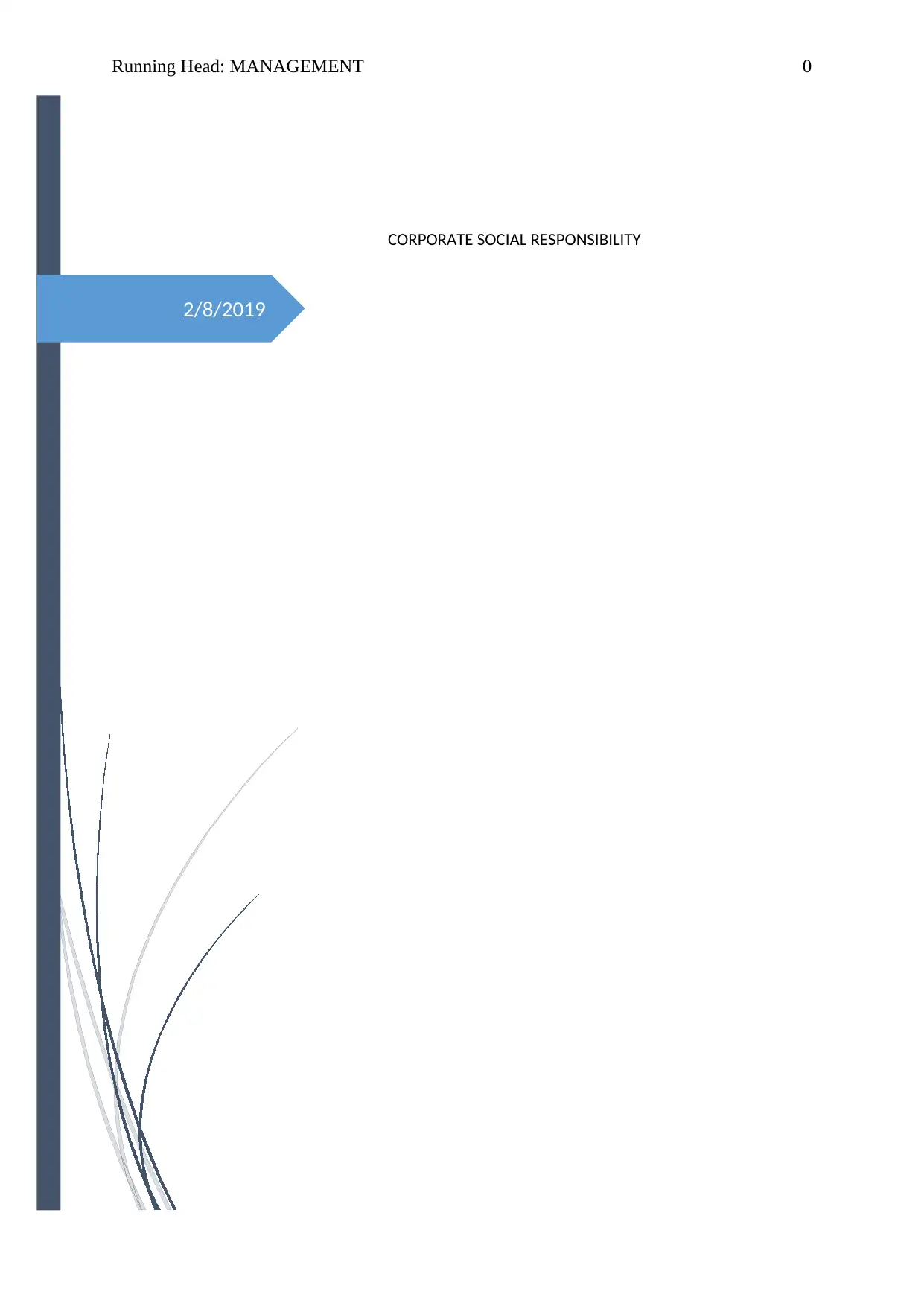
2/8/2019
Running Head: MANAGEMENT 0
CORPORATE SOCIAL RESPONSIBILITY
Running Head: MANAGEMENT 0
CORPORATE SOCIAL RESPONSIBILITY
Paraphrase This Document
Need a fresh take? Get an instant paraphrase of this document with our AI Paraphraser
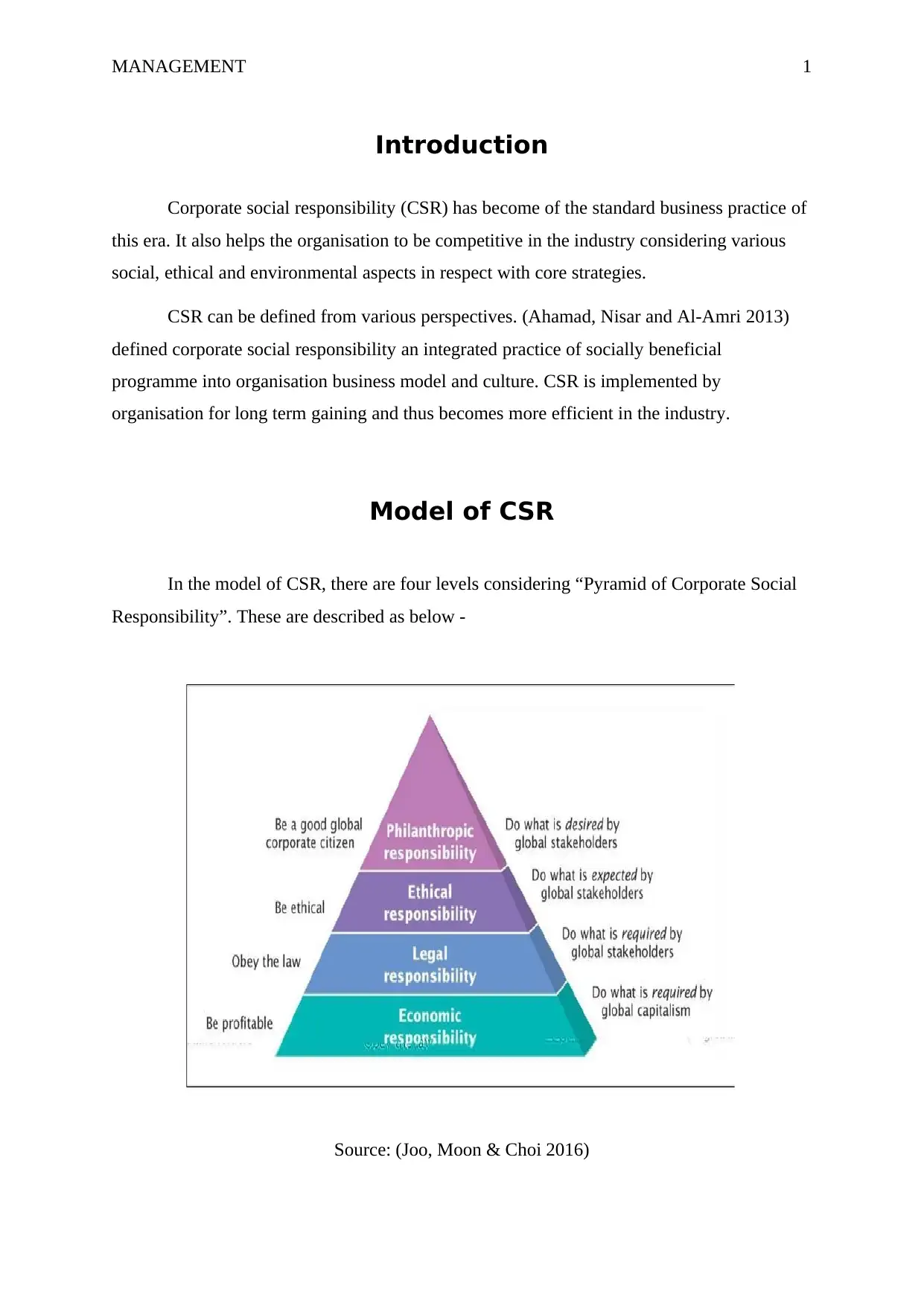
MANAGEMENT 1
Introduction
Corporate social responsibility (CSR) has become of the standard business practice of
this era. It also helps the organisation to be competitive in the industry considering various
social, ethical and environmental aspects in respect with core strategies.
CSR can be defined from various perspectives. (Ahamad, Nisar and Al-Amri 2013)
defined corporate social responsibility an integrated practice of socially beneficial
programme into organisation business model and culture. CSR is implemented by
organisation for long term gaining and thus becomes more efficient in the industry.
Model of CSR
In the model of CSR, there are four levels considering “Pyramid of Corporate Social
Responsibility”. These are described as below -
Source: (Joo, Moon & Choi 2016)
Introduction
Corporate social responsibility (CSR) has become of the standard business practice of
this era. It also helps the organisation to be competitive in the industry considering various
social, ethical and environmental aspects in respect with core strategies.
CSR can be defined from various perspectives. (Ahamad, Nisar and Al-Amri 2013)
defined corporate social responsibility an integrated practice of socially beneficial
programme into organisation business model and culture. CSR is implemented by
organisation for long term gaining and thus becomes more efficient in the industry.
Model of CSR
In the model of CSR, there are four levels considering “Pyramid of Corporate Social
Responsibility”. These are described as below -
Source: (Joo, Moon & Choi 2016)
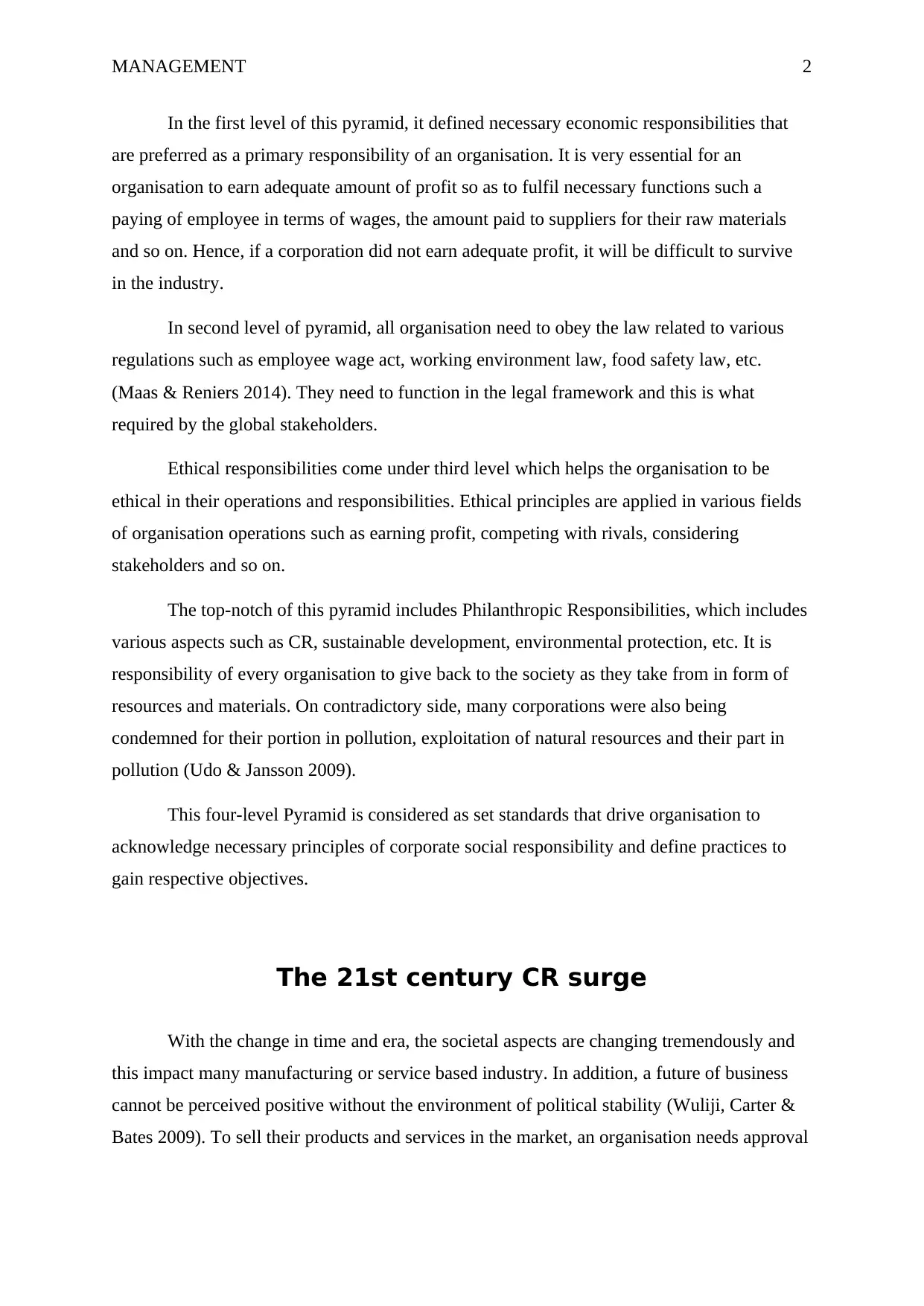
MANAGEMENT 2
In the first level of this pyramid, it defined necessary economic responsibilities that
are preferred as a primary responsibility of an organisation. It is very essential for an
organisation to earn adequate amount of profit so as to fulfil necessary functions such a
paying of employee in terms of wages, the amount paid to suppliers for their raw materials
and so on. Hence, if a corporation did not earn adequate profit, it will be difficult to survive
in the industry.
In second level of pyramid, all organisation need to obey the law related to various
regulations such as employee wage act, working environment law, food safety law, etc.
(Maas & Reniers 2014). They need to function in the legal framework and this is what
required by the global stakeholders.
Ethical responsibilities come under third level which helps the organisation to be
ethical in their operations and responsibilities. Ethical principles are applied in various fields
of organisation operations such as earning profit, competing with rivals, considering
stakeholders and so on.
The top-notch of this pyramid includes Philanthropic Responsibilities, which includes
various aspects such as CR, sustainable development, environmental protection, etc. It is
responsibility of every organisation to give back to the society as they take from in form of
resources and materials. On contradictory side, many corporations were also being
condemned for their portion in pollution, exploitation of natural resources and their part in
pollution (Udo & Jansson 2009).
This four-level Pyramid is considered as set standards that drive organisation to
acknowledge necessary principles of corporate social responsibility and define practices to
gain respective objectives.
The 21st century CR surge
With the change in time and era, the societal aspects are changing tremendously and
this impact many manufacturing or service based industry. In addition, a future of business
cannot be perceived positive without the environment of political stability (Wuliji, Carter &
Bates 2009). To sell their products and services in the market, an organisation needs approval
In the first level of this pyramid, it defined necessary economic responsibilities that
are preferred as a primary responsibility of an organisation. It is very essential for an
organisation to earn adequate amount of profit so as to fulfil necessary functions such a
paying of employee in terms of wages, the amount paid to suppliers for their raw materials
and so on. Hence, if a corporation did not earn adequate profit, it will be difficult to survive
in the industry.
In second level of pyramid, all organisation need to obey the law related to various
regulations such as employee wage act, working environment law, food safety law, etc.
(Maas & Reniers 2014). They need to function in the legal framework and this is what
required by the global stakeholders.
Ethical responsibilities come under third level which helps the organisation to be
ethical in their operations and responsibilities. Ethical principles are applied in various fields
of organisation operations such as earning profit, competing with rivals, considering
stakeholders and so on.
The top-notch of this pyramid includes Philanthropic Responsibilities, which includes
various aspects such as CR, sustainable development, environmental protection, etc. It is
responsibility of every organisation to give back to the society as they take from in form of
resources and materials. On contradictory side, many corporations were also being
condemned for their portion in pollution, exploitation of natural resources and their part in
pollution (Udo & Jansson 2009).
This four-level Pyramid is considered as set standards that drive organisation to
acknowledge necessary principles of corporate social responsibility and define practices to
gain respective objectives.
The 21st century CR surge
With the change in time and era, the societal aspects are changing tremendously and
this impact many manufacturing or service based industry. In addition, a future of business
cannot be perceived positive without the environment of political stability (Wuliji, Carter &
Bates 2009). To sell their products and services in the market, an organisation needs approval
⊘ This is a preview!⊘
Do you want full access?
Subscribe today to unlock all pages.

Trusted by 1+ million students worldwide
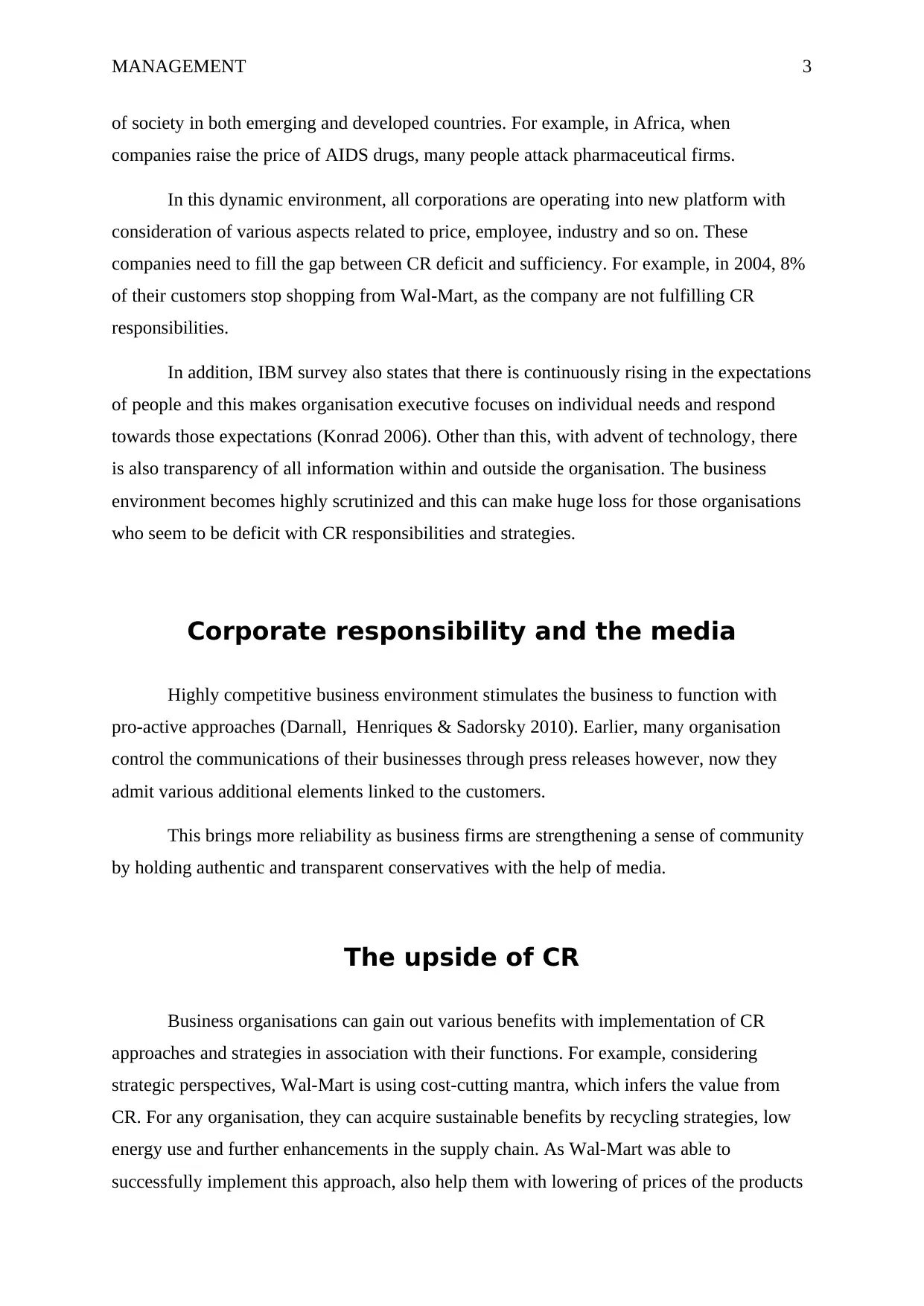
MANAGEMENT 3
of society in both emerging and developed countries. For example, in Africa, when
companies raise the price of AIDS drugs, many people attack pharmaceutical firms.
In this dynamic environment, all corporations are operating into new platform with
consideration of various aspects related to price, employee, industry and so on. These
companies need to fill the gap between CR deficit and sufficiency. For example, in 2004, 8%
of their customers stop shopping from Wal-Mart, as the company are not fulfilling CR
responsibilities.
In addition, IBM survey also states that there is continuously rising in the expectations
of people and this makes organisation executive focuses on individual needs and respond
towards those expectations (Konrad 2006). Other than this, with advent of technology, there
is also transparency of all information within and outside the organisation. The business
environment becomes highly scrutinized and this can make huge loss for those organisations
who seem to be deficit with CR responsibilities and strategies.
Corporate responsibility and the media
Highly competitive business environment stimulates the business to function with
pro-active approaches (Darnall, Henriques & Sadorsky 2010). Earlier, many organisation
control the communications of their businesses through press releases however, now they
admit various additional elements linked to the customers.
This brings more reliability as business firms are strengthening a sense of community
by holding authentic and transparent conservatives with the help of media.
The upside of CR
Business organisations can gain out various benefits with implementation of CR
approaches and strategies in association with their functions. For example, considering
strategic perspectives, Wal-Mart is using cost-cutting mantra, which infers the value from
CR. For any organisation, they can acquire sustainable benefits by recycling strategies, low
energy use and further enhancements in the supply chain. As Wal-Mart was able to
successfully implement this approach, also help them with lowering of prices of the products
of society in both emerging and developed countries. For example, in Africa, when
companies raise the price of AIDS drugs, many people attack pharmaceutical firms.
In this dynamic environment, all corporations are operating into new platform with
consideration of various aspects related to price, employee, industry and so on. These
companies need to fill the gap between CR deficit and sufficiency. For example, in 2004, 8%
of their customers stop shopping from Wal-Mart, as the company are not fulfilling CR
responsibilities.
In addition, IBM survey also states that there is continuously rising in the expectations
of people and this makes organisation executive focuses on individual needs and respond
towards those expectations (Konrad 2006). Other than this, with advent of technology, there
is also transparency of all information within and outside the organisation. The business
environment becomes highly scrutinized and this can make huge loss for those organisations
who seem to be deficit with CR responsibilities and strategies.
Corporate responsibility and the media
Highly competitive business environment stimulates the business to function with
pro-active approaches (Darnall, Henriques & Sadorsky 2010). Earlier, many organisation
control the communications of their businesses through press releases however, now they
admit various additional elements linked to the customers.
This brings more reliability as business firms are strengthening a sense of community
by holding authentic and transparent conservatives with the help of media.
The upside of CR
Business organisations can gain out various benefits with implementation of CR
approaches and strategies in association with their functions. For example, considering
strategic perspectives, Wal-Mart is using cost-cutting mantra, which infers the value from
CR. For any organisation, they can acquire sustainable benefits by recycling strategies, low
energy use and further enhancements in the supply chain. As Wal-Mart was able to
successfully implement this approach, also help them with lowering of prices of the products
Paraphrase This Document
Need a fresh take? Get an instant paraphrase of this document with our AI Paraphraser
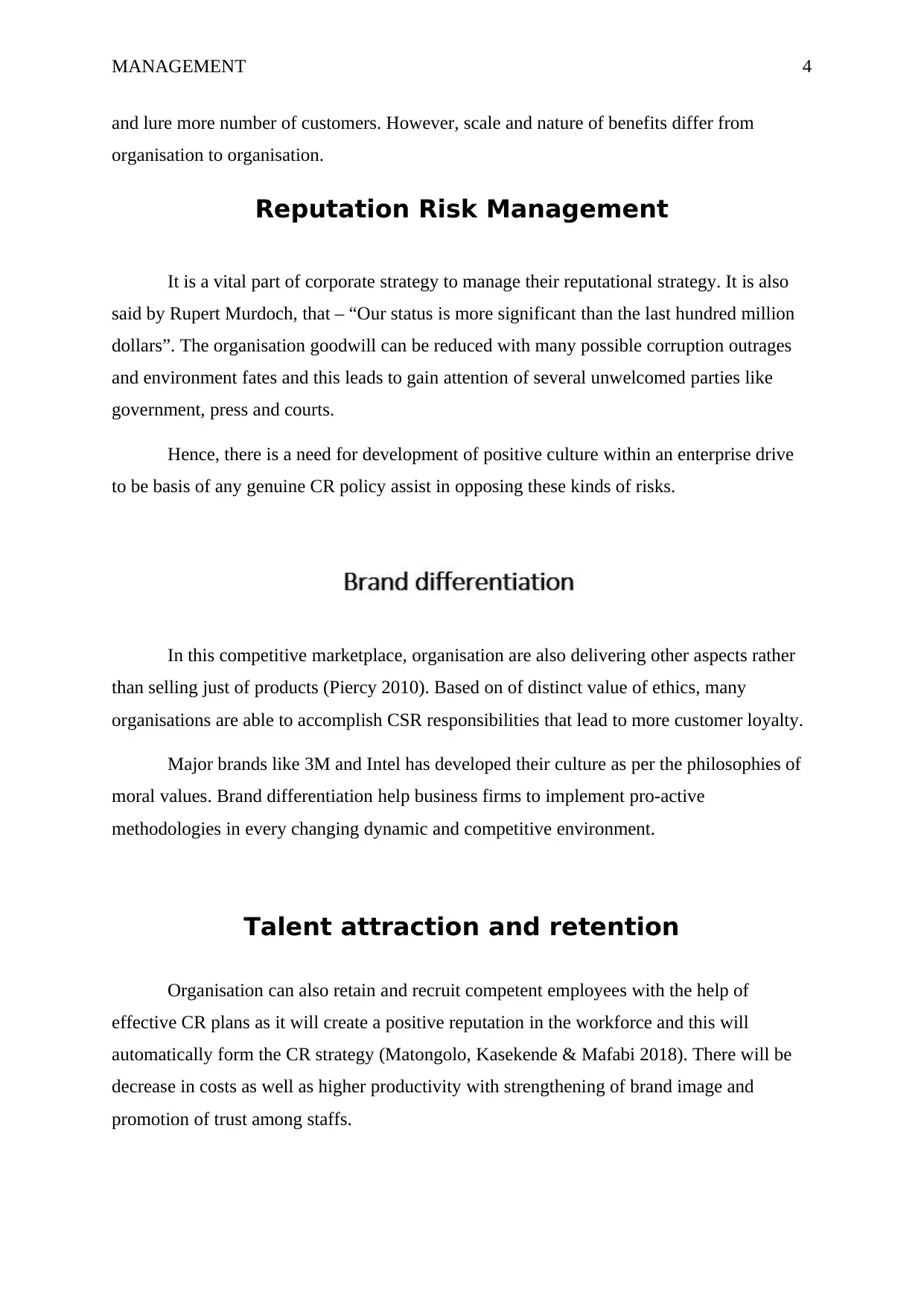
MANAGEMENT 4
and lure more number of customers. However, scale and nature of benefits differ from
organisation to organisation.
Reputation Risk Management
It is a vital part of corporate strategy to manage their reputational strategy. It is also
said by Rupert Murdoch, that – “Our status is more significant than the last hundred million
dollars”. The organisation goodwill can be reduced with many possible corruption outrages
and environment fates and this leads to gain attention of several unwelcomed parties like
government, press and courts.
Hence, there is a need for development of positive culture within an enterprise drive
to be basis of any genuine CR policy assist in opposing these kinds of risks.
In this competitive marketplace, organisation are also delivering other aspects rather
than selling just of products (Piercy 2010). Based on of distinct value of ethics, many
organisations are able to accomplish CSR responsibilities that lead to more customer loyalty.
Major brands like 3M and Intel has developed their culture as per the philosophies of
moral values. Brand differentiation help business firms to implement pro-active
methodologies in every changing dynamic and competitive environment.
Talent attraction and retention
Organisation can also retain and recruit competent employees with the help of
effective CR plans as it will create a positive reputation in the workforce and this will
automatically form the CR strategy (Matongolo, Kasekende & Mafabi 2018). There will be
decrease in costs as well as higher productivity with strengthening of brand image and
promotion of trust among staffs.
and lure more number of customers. However, scale and nature of benefits differ from
organisation to organisation.
Reputation Risk Management
It is a vital part of corporate strategy to manage their reputational strategy. It is also
said by Rupert Murdoch, that – “Our status is more significant than the last hundred million
dollars”. The organisation goodwill can be reduced with many possible corruption outrages
and environment fates and this leads to gain attention of several unwelcomed parties like
government, press and courts.
Hence, there is a need for development of positive culture within an enterprise drive
to be basis of any genuine CR policy assist in opposing these kinds of risks.
In this competitive marketplace, organisation are also delivering other aspects rather
than selling just of products (Piercy 2010). Based on of distinct value of ethics, many
organisations are able to accomplish CSR responsibilities that lead to more customer loyalty.
Major brands like 3M and Intel has developed their culture as per the philosophies of
moral values. Brand differentiation help business firms to implement pro-active
methodologies in every changing dynamic and competitive environment.
Talent attraction and retention
Organisation can also retain and recruit competent employees with the help of
effective CR plans as it will create a positive reputation in the workforce and this will
automatically form the CR strategy (Matongolo, Kasekende & Mafabi 2018). There will be
decrease in costs as well as higher productivity with strengthening of brand image and
promotion of trust among staffs.
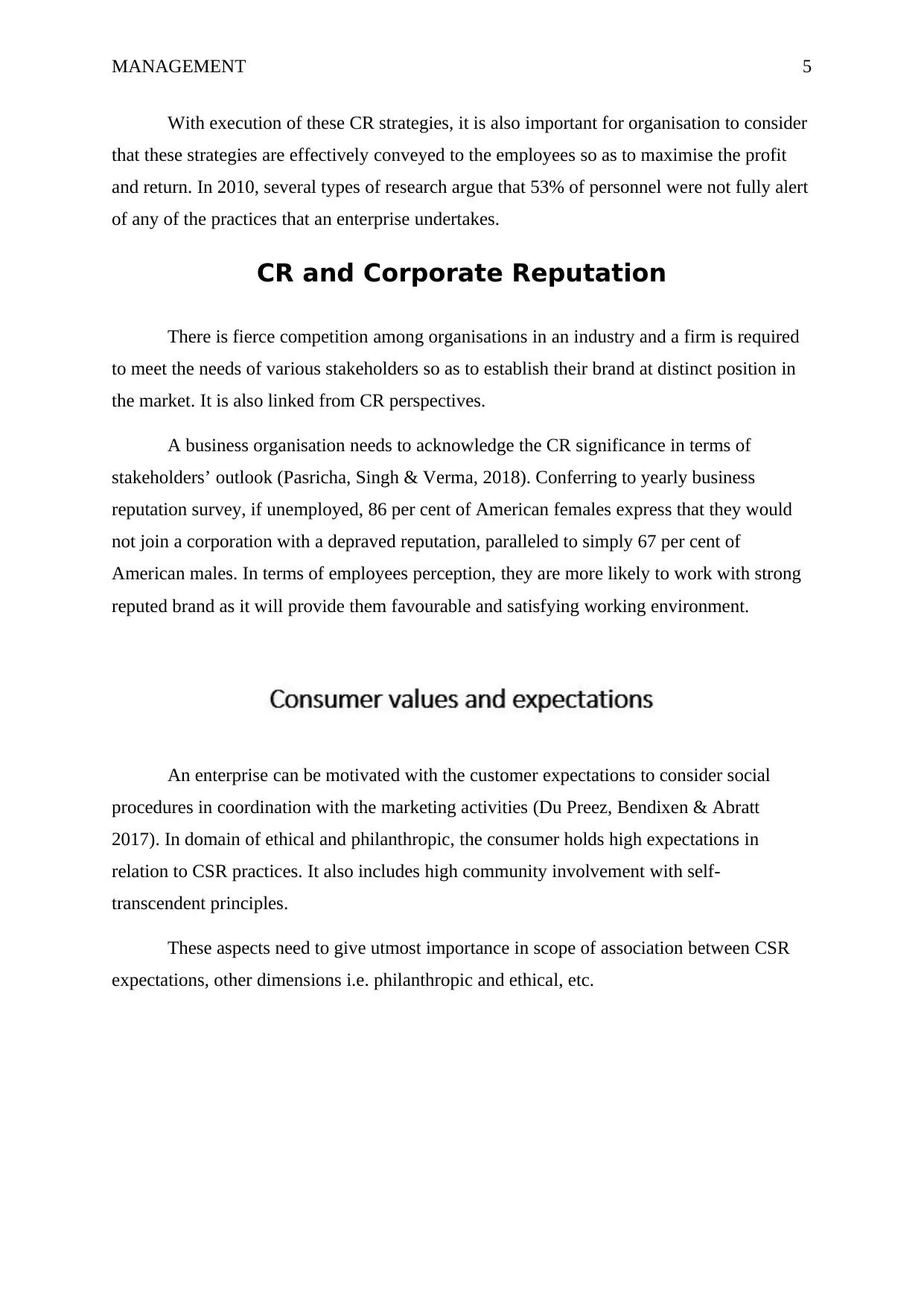
MANAGEMENT 5
With execution of these CR strategies, it is also important for organisation to consider
that these strategies are effectively conveyed to the employees so as to maximise the profit
and return. In 2010, several types of research argue that 53% of personnel were not fully alert
of any of the practices that an enterprise undertakes.
CR and Corporate Reputation
There is fierce competition among organisations in an industry and a firm is required
to meet the needs of various stakeholders so as to establish their brand at distinct position in
the market. It is also linked from CR perspectives.
A business organisation needs to acknowledge the CR significance in terms of
stakeholders’ outlook (Pasricha, Singh & Verma, 2018). Conferring to yearly business
reputation survey, if unemployed, 86 per cent of American females express that they would
not join a corporation with a depraved reputation, paralleled to simply 67 per cent of
American males. In terms of employees perception, they are more likely to work with strong
reputed brand as it will provide them favourable and satisfying working environment.
An enterprise can be motivated with the customer expectations to consider social
procedures in coordination with the marketing activities (Du Preez, Bendixen & Abratt
2017). In domain of ethical and philanthropic, the consumer holds high expectations in
relation to CSR practices. It also includes high community involvement with self-
transcendent principles.
These aspects need to give utmost importance in scope of association between CSR
expectations, other dimensions i.e. philanthropic and ethical, etc.
With execution of these CR strategies, it is also important for organisation to consider
that these strategies are effectively conveyed to the employees so as to maximise the profit
and return. In 2010, several types of research argue that 53% of personnel were not fully alert
of any of the practices that an enterprise undertakes.
CR and Corporate Reputation
There is fierce competition among organisations in an industry and a firm is required
to meet the needs of various stakeholders so as to establish their brand at distinct position in
the market. It is also linked from CR perspectives.
A business organisation needs to acknowledge the CR significance in terms of
stakeholders’ outlook (Pasricha, Singh & Verma, 2018). Conferring to yearly business
reputation survey, if unemployed, 86 per cent of American females express that they would
not join a corporation with a depraved reputation, paralleled to simply 67 per cent of
American males. In terms of employees perception, they are more likely to work with strong
reputed brand as it will provide them favourable and satisfying working environment.
An enterprise can be motivated with the customer expectations to consider social
procedures in coordination with the marketing activities (Du Preez, Bendixen & Abratt
2017). In domain of ethical and philanthropic, the consumer holds high expectations in
relation to CSR practices. It also includes high community involvement with self-
transcendent principles.
These aspects need to give utmost importance in scope of association between CSR
expectations, other dimensions i.e. philanthropic and ethical, etc.
⊘ This is a preview!⊘
Do you want full access?
Subscribe today to unlock all pages.

Trusted by 1+ million students worldwide
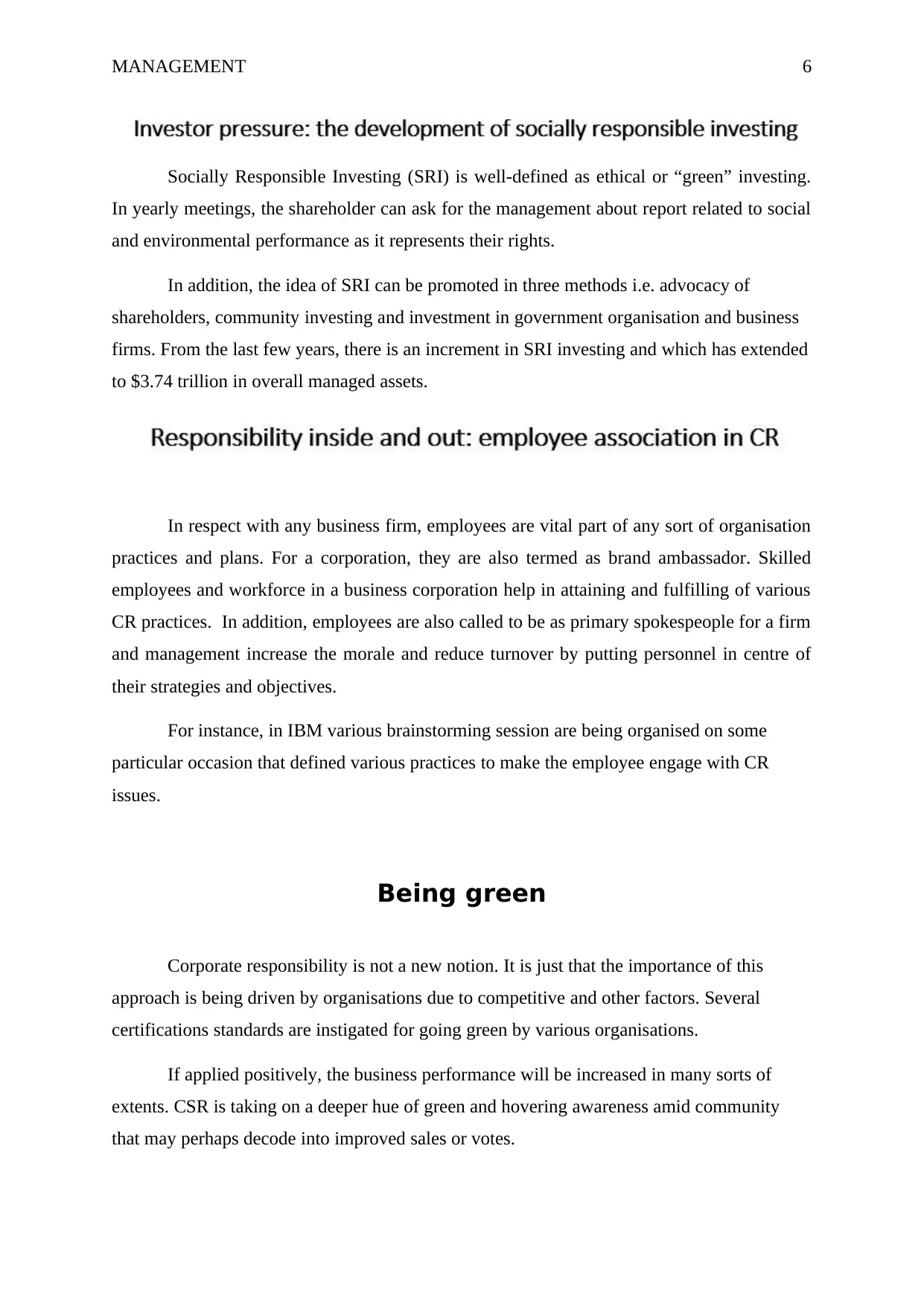
MANAGEMENT 6
Socially Responsible Investing (SRI) is well-defined as ethical or “green” investing.
In yearly meetings, the shareholder can ask for the management about report related to social
and environmental performance as it represents their rights.
In addition, the idea of SRI can be promoted in three methods i.e. advocacy of
shareholders, community investing and investment in government organisation and business
firms. From the last few years, there is an increment in SRI investing and which has extended
to $3.74 trillion in overall managed assets.
In respect with any business firm, employees are vital part of any sort of organisation
practices and plans. For a corporation, they are also termed as brand ambassador. Skilled
employees and workforce in a business corporation help in attaining and fulfilling of various
CR practices. In addition, employees are also called to be as primary spokespeople for a firm
and management increase the morale and reduce turnover by putting personnel in centre of
their strategies and objectives.
For instance, in IBM various brainstorming session are being organised on some
particular occasion that defined various practices to make the employee engage with CR
issues.
Being green
Corporate responsibility is not a new notion. It is just that the importance of this
approach is being driven by organisations due to competitive and other factors. Several
certifications standards are instigated for going green by various organisations.
If applied positively, the business performance will be increased in many sorts of
extents. CSR is taking on a deeper hue of green and hovering awareness amid community
that may perhaps decode into improved sales or votes.
Socially Responsible Investing (SRI) is well-defined as ethical or “green” investing.
In yearly meetings, the shareholder can ask for the management about report related to social
and environmental performance as it represents their rights.
In addition, the idea of SRI can be promoted in three methods i.e. advocacy of
shareholders, community investing and investment in government organisation and business
firms. From the last few years, there is an increment in SRI investing and which has extended
to $3.74 trillion in overall managed assets.
In respect with any business firm, employees are vital part of any sort of organisation
practices and plans. For a corporation, they are also termed as brand ambassador. Skilled
employees and workforce in a business corporation help in attaining and fulfilling of various
CR practices. In addition, employees are also called to be as primary spokespeople for a firm
and management increase the morale and reduce turnover by putting personnel in centre of
their strategies and objectives.
For instance, in IBM various brainstorming session are being organised on some
particular occasion that defined various practices to make the employee engage with CR
issues.
Being green
Corporate responsibility is not a new notion. It is just that the importance of this
approach is being driven by organisations due to competitive and other factors. Several
certifications standards are instigated for going green by various organisations.
If applied positively, the business performance will be increased in many sorts of
extents. CSR is taking on a deeper hue of green and hovering awareness amid community
that may perhaps decode into improved sales or votes.
Paraphrase This Document
Need a fresh take? Get an instant paraphrase of this document with our AI Paraphraser
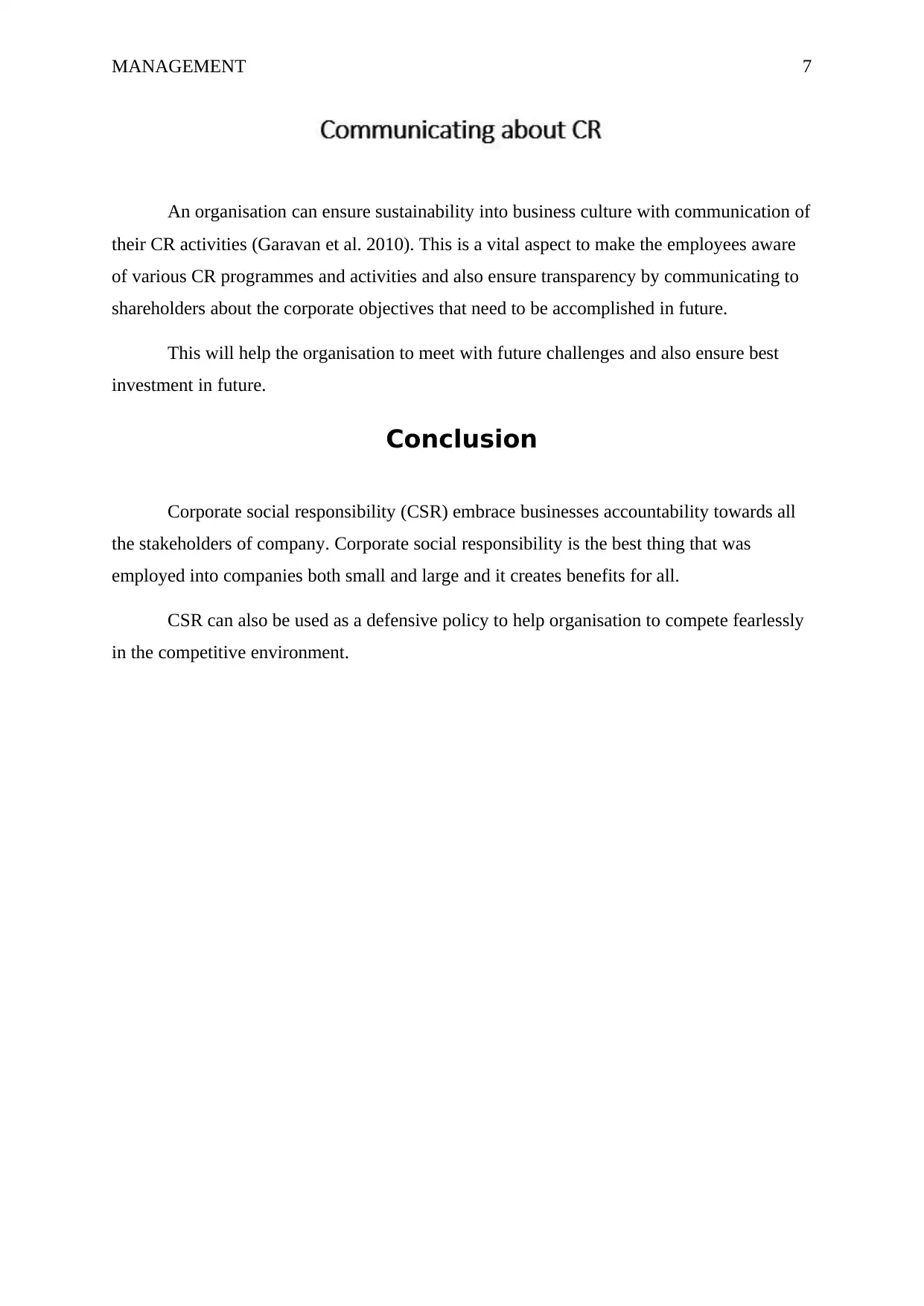
MANAGEMENT 7
An organisation can ensure sustainability into business culture with communication of
their CR activities (Garavan et al. 2010). This is a vital aspect to make the employees aware
of various CR programmes and activities and also ensure transparency by communicating to
shareholders about the corporate objectives that need to be accomplished in future.
This will help the organisation to meet with future challenges and also ensure best
investment in future.
Conclusion
Corporate social responsibility (CSR) embrace businesses accountability towards all
the stakeholders of company. Corporate social responsibility is the best thing that was
employed into companies both small and large and it creates benefits for all.
CSR can also be used as a defensive policy to help organisation to compete fearlessly
in the competitive environment.
An organisation can ensure sustainability into business culture with communication of
their CR activities (Garavan et al. 2010). This is a vital aspect to make the employees aware
of various CR programmes and activities and also ensure transparency by communicating to
shareholders about the corporate objectives that need to be accomplished in future.
This will help the organisation to meet with future challenges and also ensure best
investment in future.
Conclusion
Corporate social responsibility (CSR) embrace businesses accountability towards all
the stakeholders of company. Corporate social responsibility is the best thing that was
employed into companies both small and large and it creates benefits for all.
CSR can also be used as a defensive policy to help organisation to compete fearlessly
in the competitive environment.
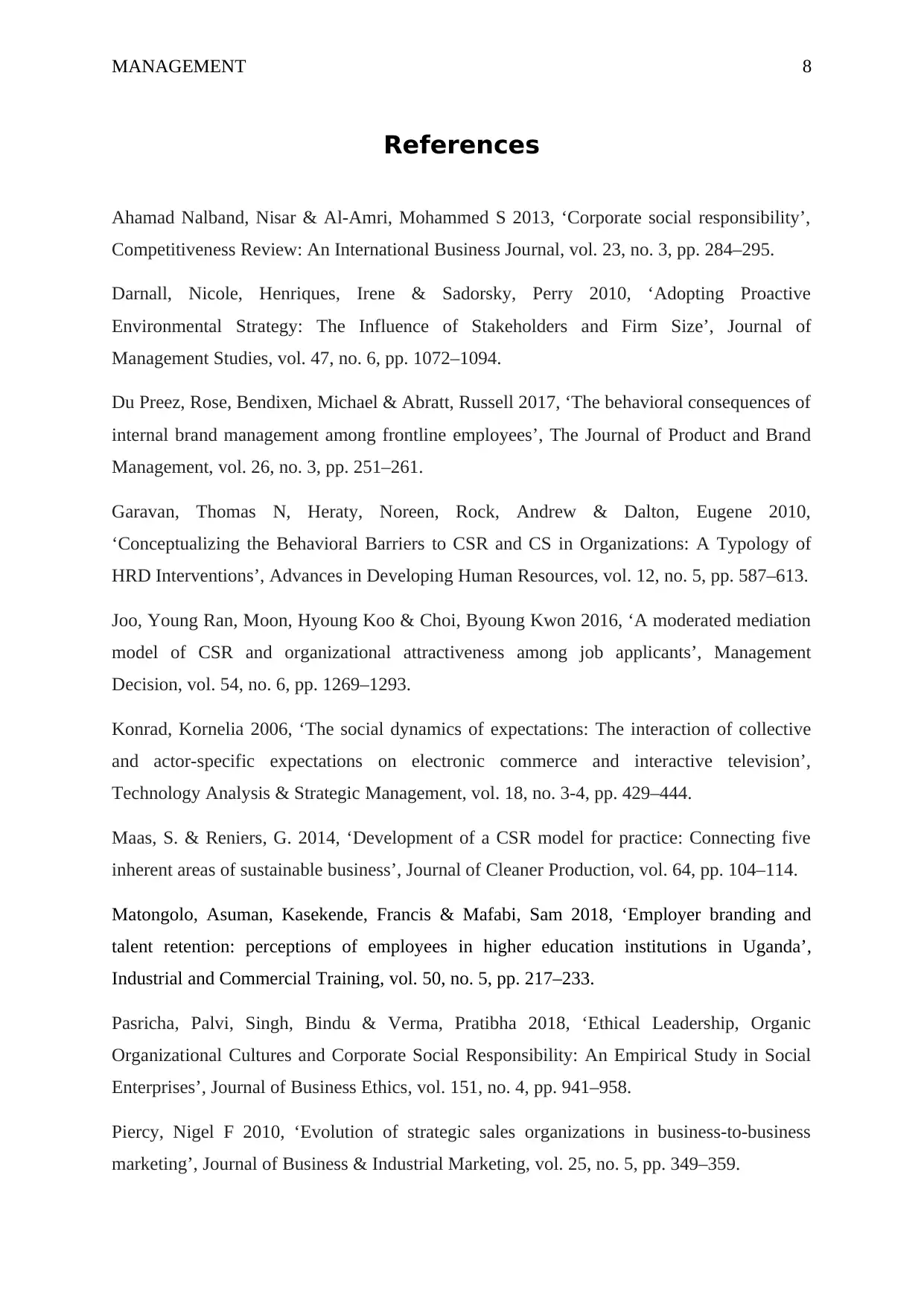
MANAGEMENT 8
References
Ahamad Nalband, Nisar & Al-Amri, Mohammed S 2013, ‘Corporate social responsibility’,
Competitiveness Review: An International Business Journal, vol. 23, no. 3, pp. 284–295.
Darnall, Nicole, Henriques, Irene & Sadorsky, Perry 2010, ‘Adopting Proactive
Environmental Strategy: The Influence of Stakeholders and Firm Size’, Journal of
Management Studies, vol. 47, no. 6, pp. 1072–1094.
Du Preez, Rose, Bendixen, Michael & Abratt, Russell 2017, ‘The behavioral consequences of
internal brand management among frontline employees’, The Journal of Product and Brand
Management, vol. 26, no. 3, pp. 251–261.
Garavan, Thomas N, Heraty, Noreen, Rock, Andrew & Dalton, Eugene 2010,
‘Conceptualizing the Behavioral Barriers to CSR and CS in Organizations: A Typology of
HRD Interventions’, Advances in Developing Human Resources, vol. 12, no. 5, pp. 587–613.
Joo, Young Ran, Moon, Hyoung Koo & Choi, Byoung Kwon 2016, ‘A moderated mediation
model of CSR and organizational attractiveness among job applicants’, Management
Decision, vol. 54, no. 6, pp. 1269–1293.
Konrad, Kornelia 2006, ‘The social dynamics of expectations: The interaction of collective
and actor-specific expectations on electronic commerce and interactive television’,
Technology Analysis & Strategic Management, vol. 18, no. 3-4, pp. 429–444.
Maas, S. & Reniers, G. 2014, ‘Development of a CSR model for practice: Connecting five
inherent areas of sustainable business’, Journal of Cleaner Production, vol. 64, pp. 104–114.
Matongolo, Asuman, Kasekende, Francis & Mafabi, Sam 2018, ‘Employer branding and
talent retention: perceptions of employees in higher education institutions in Uganda’,
Industrial and Commercial Training, vol. 50, no. 5, pp. 217–233.
Pasricha, Palvi, Singh, Bindu & Verma, Pratibha 2018, ‘Ethical Leadership, Organic
Organizational Cultures and Corporate Social Responsibility: An Empirical Study in Social
Enterprises’, Journal of Business Ethics, vol. 151, no. 4, pp. 941–958.
Piercy, Nigel F 2010, ‘Evolution of strategic sales organizations in business-to-business
marketing’, Journal of Business & Industrial Marketing, vol. 25, no. 5, pp. 349–359.
References
Ahamad Nalband, Nisar & Al-Amri, Mohammed S 2013, ‘Corporate social responsibility’,
Competitiveness Review: An International Business Journal, vol. 23, no. 3, pp. 284–295.
Darnall, Nicole, Henriques, Irene & Sadorsky, Perry 2010, ‘Adopting Proactive
Environmental Strategy: The Influence of Stakeholders and Firm Size’, Journal of
Management Studies, vol. 47, no. 6, pp. 1072–1094.
Du Preez, Rose, Bendixen, Michael & Abratt, Russell 2017, ‘The behavioral consequences of
internal brand management among frontline employees’, The Journal of Product and Brand
Management, vol. 26, no. 3, pp. 251–261.
Garavan, Thomas N, Heraty, Noreen, Rock, Andrew & Dalton, Eugene 2010,
‘Conceptualizing the Behavioral Barriers to CSR and CS in Organizations: A Typology of
HRD Interventions’, Advances in Developing Human Resources, vol. 12, no. 5, pp. 587–613.
Joo, Young Ran, Moon, Hyoung Koo & Choi, Byoung Kwon 2016, ‘A moderated mediation
model of CSR and organizational attractiveness among job applicants’, Management
Decision, vol. 54, no. 6, pp. 1269–1293.
Konrad, Kornelia 2006, ‘The social dynamics of expectations: The interaction of collective
and actor-specific expectations on electronic commerce and interactive television’,
Technology Analysis & Strategic Management, vol. 18, no. 3-4, pp. 429–444.
Maas, S. & Reniers, G. 2014, ‘Development of a CSR model for practice: Connecting five
inherent areas of sustainable business’, Journal of Cleaner Production, vol. 64, pp. 104–114.
Matongolo, Asuman, Kasekende, Francis & Mafabi, Sam 2018, ‘Employer branding and
talent retention: perceptions of employees in higher education institutions in Uganda’,
Industrial and Commercial Training, vol. 50, no. 5, pp. 217–233.
Pasricha, Palvi, Singh, Bindu & Verma, Pratibha 2018, ‘Ethical Leadership, Organic
Organizational Cultures and Corporate Social Responsibility: An Empirical Study in Social
Enterprises’, Journal of Business Ethics, vol. 151, no. 4, pp. 941–958.
Piercy, Nigel F 2010, ‘Evolution of strategic sales organizations in business-to-business
marketing’, Journal of Business & Industrial Marketing, vol. 25, no. 5, pp. 349–359.
⊘ This is a preview!⊘
Do you want full access?
Subscribe today to unlock all pages.

Trusted by 1+ million students worldwide
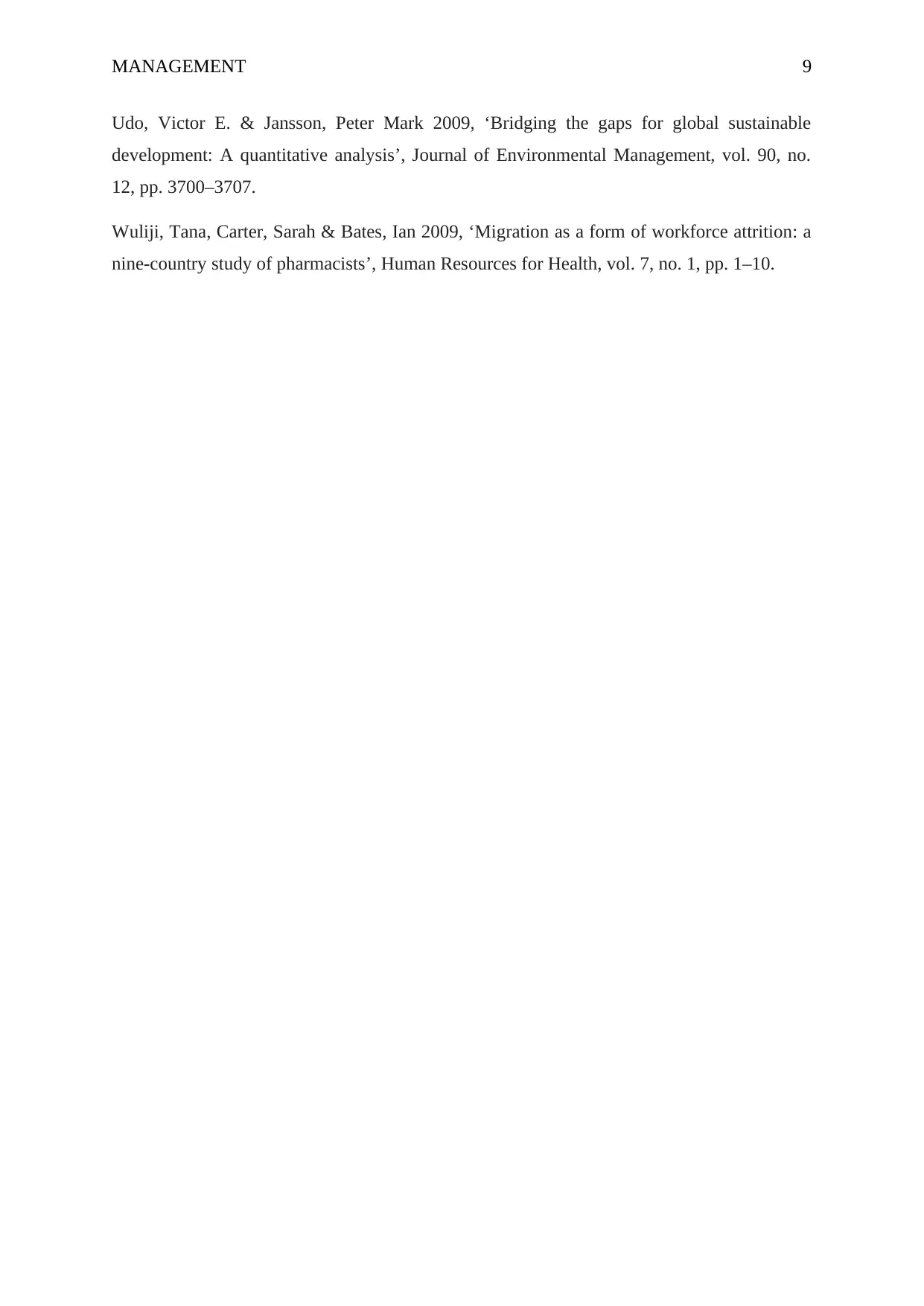
MANAGEMENT 9
Udo, Victor E. & Jansson, Peter Mark 2009, ‘Bridging the gaps for global sustainable
development: A quantitative analysis’, Journal of Environmental Management, vol. 90, no.
12, pp. 3700–3707.
Wuliji, Tana, Carter, Sarah & Bates, Ian 2009, ‘Migration as a form of workforce attrition: a
nine-country study of pharmacists’, Human Resources for Health, vol. 7, no. 1, pp. 1–10.
Udo, Victor E. & Jansson, Peter Mark 2009, ‘Bridging the gaps for global sustainable
development: A quantitative analysis’, Journal of Environmental Management, vol. 90, no.
12, pp. 3700–3707.
Wuliji, Tana, Carter, Sarah & Bates, Ian 2009, ‘Migration as a form of workforce attrition: a
nine-country study of pharmacists’, Human Resources for Health, vol. 7, no. 1, pp. 1–10.
1 out of 10
Related Documents
Your All-in-One AI-Powered Toolkit for Academic Success.
+13062052269
info@desklib.com
Available 24*7 on WhatsApp / Email
![[object Object]](/_next/static/media/star-bottom.7253800d.svg)
Unlock your academic potential
Copyright © 2020–2025 A2Z Services. All Rights Reserved. Developed and managed by ZUCOL.





